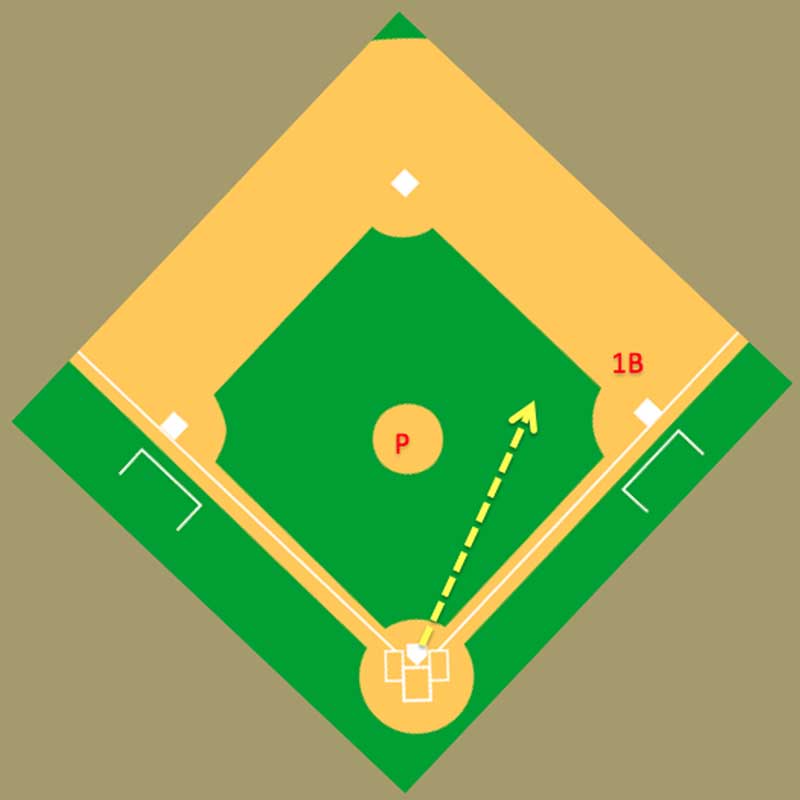What is a Sacrifice Bunt?
A sacrifice bunt, often referred to simply as a “sacrifice,” is a strategic play in baseball or softball where a batter intentionally hits the ball with the goal of advancing a baserunner to a higher base, while sacrificing their own chance of reaching base safely. This play is primarily used to move a runner from first base to second base or from second base to third base, though there are situations where it might be employed to move a runner from third base to home plate.

How to Sacrifice Bunt?
- Choose the Right Moment: Sacrifice bunts are typically employed in specific game situations, such as when there are runners on base and you want to advance them to a better scoring position. Make sure it’s the right time to attempt a sacrifice bunt based on the game situation and your team’s strategy.
- Stance and Grip: Position yourself in the batter’s box with your feet square to the pitcher, and hold the bat with both hands close together toward the top of the handle. You’ll want to choke up on the bat for better control.
- Square to the Pitcher: As the pitcher begins their windup, pivot your body so you’re facing the pitcher directly. Square your shoulders and hips to the pitcher to improve your bunting accuracy.
- Prepare for the Pitch: Keep your eyes on the pitcher and be ready to react to the pitch. Your primary goal is to make contact with the ball.
- Bunt Technique: When the pitch is coming, shift your weight forward slightly onto your front foot. Extend your arms and angle the bat slightly upward to make contact with the ball as it approaches the strike zone.
- Contact and Placement: As the pitch reaches you, focus on making contact with the ball near the top half of the bat. Aim to bunt the ball softly and place it in an area that will make it challenging for the fielders to make a play. This often means bunting it down the first or third base line.
- Runner’s Start: If there’s a baserunner you’re trying to advance, they should get a good jump off their base as soon as they see you successfully make contact with the ball.
- Sprint to First Base: After bunting the ball, immediately sprint towards first base as fast as you can. Your goal is to try to beat the throw from the fielding team.
- Monitor the Play: Keep an eye on the fielders as they try to field the bunted ball. If they fumble it or take too long to make a throw, you might have a chance to reach first base safely.
- Communication: Communication between you and the runner(s) is crucial. Ensure that the baserunners are aware of your intention to sacrifice bunt, so they’re ready to advance when you make contact.
- Practice: Sacrifice bunting requires practice to develop accuracy and consistency. Spend time in batting practice working on your bunting skills to become more proficient.
When is the appropriate moment to lay down a sacrifice bunt aimed at first base?

You should consider putting down a sacrifice bunt towards first base in specific game situations when it strategically makes sense. Here are some scenarios when a sacrifice bunt towards first base can be a smart play:
- Runner on First, No Outs: If there’s a runner on first base with no outs, a sacrifice bunt towards first base can advance that runner to second base while trading an out for better scoring position.
- Late Innings in a Close Game: In late innings of a close game, a single run can make a big difference. Sacrificing to advance a runner to scoring position can be especially valuable in these situations.
- Pitcher’s Duel: When the game is a low-scoring affair or a pitcher’s duel, runs can be hard to come by. Sacrifice bunting in this situation can help manufacture a run without relying on a hit.
- Weaker Hitters: If the batter at the plate is a weaker hitter or not known for their ability to get on base consistently, sacrificing to advance a runner can be a strategic move.
- Leadoff Double: If the inning starts with a runner hitting a double, sacrificing them to third base can increase the chances of scoring them with a simple hit or fly ball.
- Speedy Runner: If the runner on first base is particularly fast, sacrificing them to second base can put them in scoring position for a subsequent base hit.
- Defensive Weakness: If you notice a defensive weakness on the right side of the infield (the first baseman or second baseman), you might choose to bunt towards first base to exploit that vulnerability.
- Pitcher’s Control Issues: If the opposing pitcher is struggling with their control and frequently throwing balls, you can use a sacrifice bunt to ensure you’re advancing a runner without risking a walk.
- Team Strategy: Your team’s overall strategy and the manager’s preference may also dictate when to use a sacrifice bunt. Some teams employ small ball tactics, including frequent bunting, as a core part of their game plan.
When is the right time to execute a sacrifice bunt directed towards third base?

A sacrifice bunt towards third base can be strategically employed in baseball in specific game situations when it makes sense to advance a runner to a higher base while sacrificing the batter’s opportunity to reach base safely. Here are some scenarios when a sacrifice bunt towards third base can be a smart play:
- Runner on Second, No Outs: If there’s a runner on second base with no outs, a sacrifice bunt towards third base can advance that runner to third while trading an out for a better scoring position. This puts the runner 90 feet away from home plate, making it easier to score on a subsequent hit, sacrifice fly, or even a wild pitch.
- Late Innings in a Close Game: In late innings of a close game, particularly in low-scoring affairs, a single run can be crucial. Sacrificing to advance a runner to third base can increase the likelihood of scoring that runner with a hit, fly ball, or squeeze play.
- Pitcher’s Duel: When the game is a pitching duel and runs are scarce, employing a sacrifice bunt towards third can help manufacture a run without relying on a hit.
- Speedy Runner on Second: If the runner on second base is exceptionally fast, they may have a better chance of scoring from third on a hit, even if it’s not deep, due to their speed. Sacrificing to move them to third can be a wise move in this case.
- Leadoff Triple: If the inning begins with a runner hitting a triple, you might consider sacrificing to third base to ensure they are 90 feet away from scoring.
- Defensive Weakness: If you notice a defensive weakness on the left side of the infield (the third baseman or shortstop), bunting towards third base can exploit that vulnerability.
- Pitcher’s Control Issues: If the opposing pitcher is struggling with their control and frequently throwing balls, you can use a sacrifice bunt to ensure you’re advancing a runner without risking a walk.
- Team Strategy: Your team’s overall strategy and the manager’s preference may also dictate when to use a sacrifice bunt. Some teams employ small ball tactics, including frequent bunting, as a core part of their game plan.
